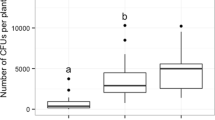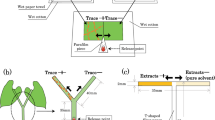Abstract
Phytoseiid mites, both in agricultural and natural systems, can play an important role in the regulation of herbivorous mites. Host plant traits, such as leaf pubescence, may influence the dynamics between predator and prey. In this study, we examined the influence of leaf surface characteristics (leaf pubescence and two-spotted spider mite webbing) on the behavior of two species of predatory mites, the generalist Typhlodromus pyri and the spider mite specialist Phytoseiulus persimilis. In laboratory trials, T. pyri females consistently spent more time and deposited more eggs on leaf discs from trichome-rich apple varieties compared to relatively trichome-poor varieties. A similar result was found when the choice involved trichome-rich and trichome-poor apple varieties planted into the same pot where leaves were allowed to touch so that the mites could freely move from leaf to leaf. To further explore the effect of structure created by pubescence and to remove possible confounding effects of chemical cues, we added cotton fibers to trichome-free bean leaves. T. pyri females consistently spent more time and deposited more eggs on the side of a glabrous bean leaf with artificial cotton fibers versus the side without added fibers. When given a choice between two densities of cotton fibers, T. pyri females consistently selected the highest density of available fibers in which to to reside and oviposit. T. pyri also preferred cotton fiber configurations in which it could move underneath and access the plant surface. The artificial pubescent leaf was also used to test the effect of leaf hairs and two-spotted spider mite webbing on the behavior of P. persimilis. P. persimilis females preferred residing and ovipositing on surfaces with cotton fibers or two-spotted spider mite webbing than on bean leaf areas without these structures. When presented a choice between cotton fibers or webbing, the behavior of P. persimilis females depended on the cotton fiber density. In a mixed-variety apple orchard, we investigated the relationship between leaf pubescence and phytoseiid density under field conditions. We found a highly significant, positive relationship between density of trichomes on leaves and abundance of T. pyri, whereas spider mite prey numbers were uniformly low and unrelated to trichome density. These field results suggest that the behavioral responses found in our laboratory experiments have population consequences.
Similar content being viewed by others
Author information
Authors and Affiliations
Additional information
Electronic Publication
Rights and permissions
About this article
Cite this article
Roda, A., Nyrop, J., English-Loeb, G. et al. Leaf pubescence and two-spotted spider mite webbing influence phytoseiid behavior and population density. Oecologia 129, 551–560 (2001). https://doi.org/10.1007/s004420100762
Received:
Accepted:
Published:
Issue Date:
DOI: https://doi.org/10.1007/s004420100762




